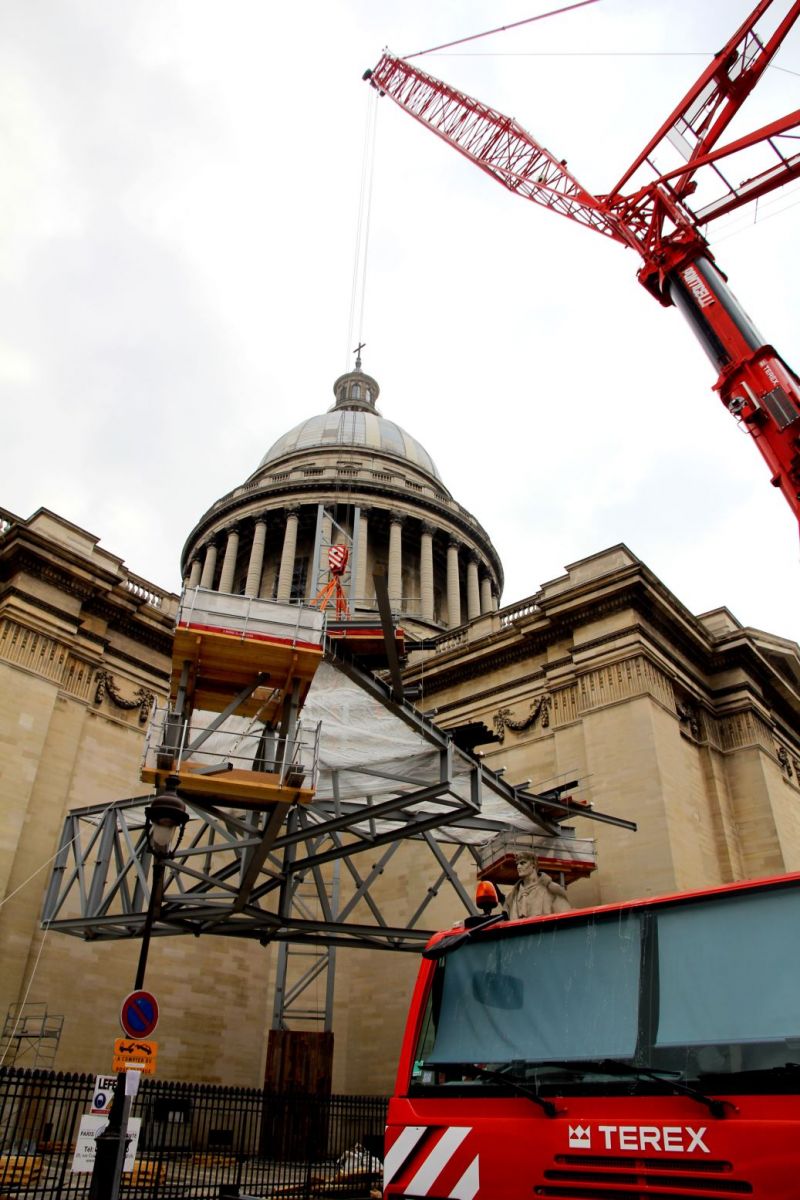All-Terrain Crane Helps Restore French Monument
 |
|
Enlarge Image
|
January 3, 2014 - Serving as a resting place for many of France's most notable citizens, including Rousseau, Voltaire, Victor Hugo, Pierre and Marie Curie, and Alexandre Dumas, the Pantheon is undergoing a facelift. French construction group Ponticelli is revitalizing the monument, employing a Terex AC 700 all-terrain crane to help raise a complex scaffolding structure for the project.
Erected between 1758 and 1790 by the French architect Soufflot on the hill known as the Montagne Sainte-Geneviève, the neo-classical structure was meant to be a church dedicated to the patron saint of Paris. The French revolution in 1789 changed the course of history: Sainte-Geneviève lost her religious vocation, and the structure instead was transformed into the temple of French secularism. Over 700,000 visitors come to this emblematic bastion of national memory each year.
However, pressure on its arches, water seepage caused by leaky joints, and corrosion of swelling metal components that have cracked open surrounding stone has compromised the stability of the Pantheon. The Centre des Monuments Nationaux, the main caretaker for the national monument system, has now undertaken a massive restoration project. The first phase of this restoration work will last until 2015, starting with the upper part of the structure at 82 meters high (nearly 270 feet). One major challenge is the monument has to remain open to the public while restoration takes place.
In order to repair its upper structure without using the historical building itself as a support, the colonnaded drum supporting the dome will be completely covered by free-standing scaffolding. In order to raise 350 tonnes of scaffolding into the air, Paris Echafaudage designed a metallic structure shaped like a kitchen stool. It consists of a reinforced hoop tightened around the base of the drum and resting on four legs, each 37 meters high and anchored by micropilons. One of the legs will serve as the base for a 96 meter-high tower crane. In order to assemble the scaffolding, Ponticelli brought in its Terex AC 700 AT crane, equipped with a 42-meter luffing jib and 140 tonnes of counterweight. “Obtaining the permits necessary to truck in and install this kind of equipment in the heart of Paris was no easy thing. But it turned out to be the best option for this type of project,” explained Stéphane Yorgui from Ponticelli’s engineering office.
Only four weeks were needed to lift the individual structures into their desired positions. The largest of these structural elements were 20x20 meters in size, weighed 42 tonnes, and had to be hoisted to a height of 40 meters. To cope with different lift profiles, the team at Ponticelli used the 42 m luffing jib and worked with varied main boom extensions and angles.
As the crane was working all around the Pantheon, the crane operator had to reposition it for every lift. This was a major consideration when choosing which crane configuration to use, as the time required to partially dismantle the crane for each reposition would have a big impact on the overall project schedule. With the chosen configuration, Ponticelli’s team needed to only remove 80 tons of counterweight to move the crane, as the AC 700 could be transported fully rigged within the jobsite.
Before each lift, the components of the enormous reinforced structure were laid out on the ground and rigged for the lifts. “These maneuvers demanded the highest level of precision, since the structure was assembled only a few centimetres away from the building. A job demanding patience that left no room for error,” insisted Dejan Kostovski, the project manager for the scaffolding company Paris Charpente. “And this shows the skill level of the crane people in this difficult site. During work hours, the Panthéon would remain open to the public, a crowded site with people milling around,” he added.
After several weeks of methodical planning and 4 weeks of precise execution, the structure was assembled and ready to be used for the massive restoration project. “The work went smoothly. The crane operators are true professionals. Their advice was very useful to our team. We will likely work with them during the disassembly process too,” ended Dejan Kostovski.


